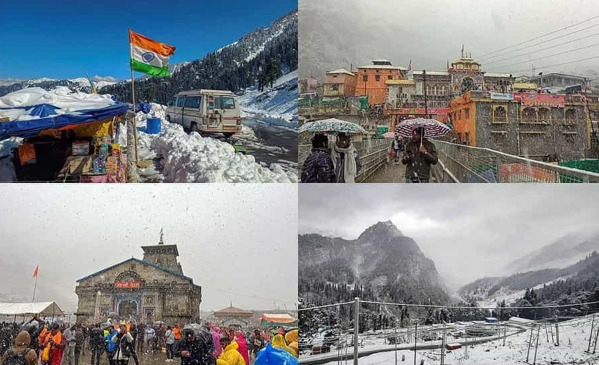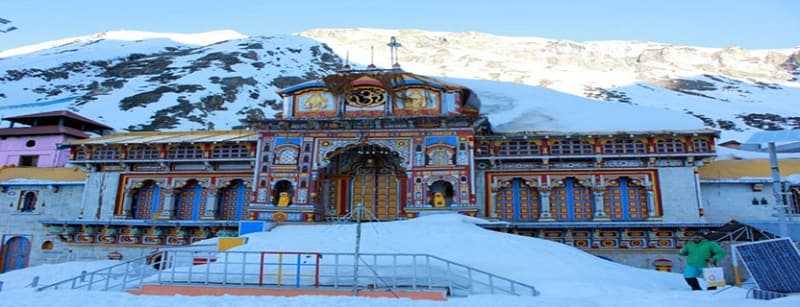Being located at such an incredible height Badrinath Dham remains open for Darshan for 6 months out of the year and during this duration the Dham remains flocked with pilgrims and devotees on their pilgrimage for salvation.
You can plan your pilgrimage according to the given month wise breakdown of the weather conditions in Badrinath along with its average temperature:
Month-Wise Badrinath Weather Details
January – The entire region remains covered in a thick layer of snow and eve the temple is buried in snow during this time. The average temperature goes to zero and even sub-zero levels. The entire area is empty and snowfall is a common occurrence during this time.
February – There is no substantial weather change during this time it remains the same as January and the temperature also remains relatively the same. The average temperature remains somewhere around 0 to 1 degree Celsius.
March – The month experiences obvious temperature change where it averages around 3 to 5 degree Celsius. Snowfall also occurs during this time in intervals. During this time the cleaning work and the preparation for the opening of the Dham shrine is underway.
April – Snowfall vanishes slowly by this month with the average temperature ranging between 6 to 10 degree Celsius. The temperature becomes more pleasant by this time of the year yet it is kind of freezing.
May – By the beginning of this month the Kapat of the Badarinath temple opens up for Darshan which generally takes place on the holy eve of Akshaya Tritiya. The temperature is pleasant and comfortable to travel since the temperature stays between 11 to 20 degree Celsius.
June – This is officially the best month to pay a visit to Badrinath Dham with the temperature ranging from 15 to even 25 degree Celsius. Although you will still be required to carry along some vital and essential woolen clothing items for a comfortable stay.
July – The month marks the onset of the rainy season but till the mid of July you can pay a comfortable visit since the temperature stays between 15 to 17 degree Celsius.
August – The entire regions gets covered in heavy rainfall with the temperature staying between 12 to 16 degree Celsius. You can talk to your tour operator to make the journey possible in between the rains. But in other cases you have the option of completely skipping this month.
September – The temperature gradually rises in this month but stays between 10 to11 degree Celsius. If your plans for visiting Badrinath Dham are on hold then you can visit it by mid or end of September.
October – October marks the onset of the winter months when the temperature stays between 10 to 8 degree Celsius and it also gradually falls. Nights are freezing cold and the days are chilly.
November – Snowfall commences from this month and this is the time when the Kapat for Badrinath Dham shuts down for 6 months during the holy eve of Vijayadashami. The temperature during this time ranges between 5 to 3 degree Celsius.
December – This is the month when the entire region gets covered in snow fall and the temperature plunges drastically to zero and sub-zero levels making pilgrimage impossible and Darshan is shut down for the season.

Summer in Badrinath
Being situated in a high altitude just like the other Chardham sites, Badrinath experiences a typical Himalayan summer time when in the morning the temperature rises and by night fall the temperature drops but not much. The weather here remains cool and pleasant in the morning and with sun down the temperature gets colder. Summer is also the best time for you to visit Badrinath which falls between the months of May to mid-July.
Monsoon in Badrinath
The temperature is easily reachable via a network of various roads that make its way to the front of the temple. The region gets covered in torrential rains during this time and rainfall is a common occurrence. The routes experience some landslides which will cause a small hiccup in your journey. If you are well coordinated with your travel operator then you will be able to go to Badrinath in between a few windows of sunny days.
strong>Winter in Badrinath
Badrinath starts getting engulfed in snow by the end of the year. When the temperature starts dropping from September the weather gets increasingly colder with day. Winter time in Badrinath lasts from October to February where the temple stays covered in snow due to the regular snowfall that covers the whole area. The weather during winter is so inhospitable that nobody can visit this place when it is closed off for Darshan.
Best Time to Visit
The months from the opening of the Dham in May to the monsoon month of early July is considered to be the best and the most appropriate time for you to offer your visit at Badrinath Dham. The overall temperature in this region during this time is extremely pleasant and comfortable for you to visit with your families. You should also visit the Dham during the months of end of September to the closing time of the temple Kapat which generally falls in November. You can do this if the winter chill is no problem for you. No matter what time of the year you decide to go the spirituality and unparalleled beauty will definitely leave an impact on you.



 Call
Call WhatsApp
WhatsApp Enquiry
Enquiry




Leave a Reply